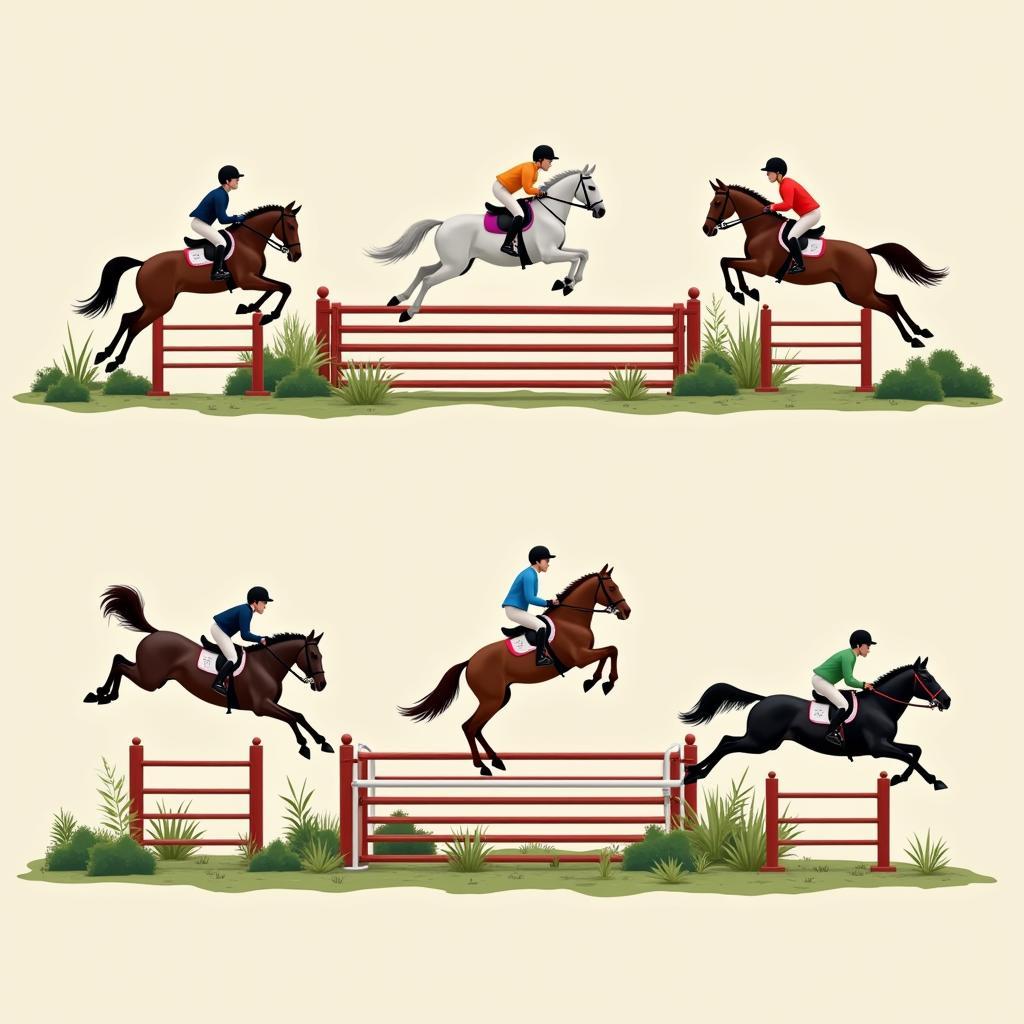Horse Jump Heights are a crucial aspect of equestrian sports, influencing everything from training regimens to competition levels. Whether you’re a seasoned competitor or a beginner just starting out, understanding the nuances of horse jump heights is essential for both rider and horse safety and success.  Horses jumping various heights
Horses jumping various heights
Decoding the Different Horse Jump Heights
Different disciplines and competition levels utilize varying horse jump heights. From the tiny cross rails for beginners to the towering fences of Grand Prix show jumping, each height presents a unique challenge. Knowing these standards helps riders set realistic goals and choose appropriate competitions. hobby horse tack set can be a good starting point for young riders interested in equestrian sports.
Common Horse Jump Height Classifications
-
Cross Rails: These are the lowest jumps, ideal for introducing horses and riders to jumping. They typically stand between 12 and 18 inches high.
-
Low Jumps: Ranging from 2′ to 2’6″, these jumps are suitable for beginner and novice riders in various disciplines.
-
Intermediate Jumps: Heights between 2’6″ and 3’6″ represent a step up in difficulty and are common in local and regional shows.
-
High Jumps: Jumps over 3’6″ require significant skill and experience, appearing in more advanced competitions.
 High Jump Competition
High Jump Competition -
Grand Prix Jumps: These are the highest jumps, often exceeding 5′ in prestigious competitions like the Olympics and World Equestrian Games.
Factors Influencing Horse Jump Heights
Several factors influence appropriate horse jump heights beyond competition level. These include the horse’s age, experience, breed, and physical capabilities. Forcing a horse to jump heights beyond its comfort level can lead to injuries and performance issues. Dr. Emily Carter, DVM, a renowned equine veterinarian, emphasizes, “Matching the jump height to the horse’s physical and mental readiness is crucial for long-term soundness and well-being.”
Age and Experience Matter
Young horses are still developing physically and mentally, and starting them over lower jumps is crucial. As they gain experience and strength, the jump height can be gradually increased. Similarly, a green horse, regardless of age, should begin with lower jumps. This gradual progression builds confidence and prevents fear or resistance to jumping.
Breed and Conformation
Certain breeds, like Warmbloods and Thoroughbreds, are often bred for jumping and have the physical attributes to excel over high jumps. However, conformation plays a significant role, with horses having longer strides and powerful hindquarters naturally suited for higher jumps. breyer horse jumps can be a fun way to explore different horse breeds and their jumping styles.
How to Determine the Right Horse Jump Height?
Choosing the correct horse jump height is a process of careful observation and gradual progression. Start with lower jumps and observe the horse’s comfort level and technique. Look for signs of hesitation, rushing, or knocking down rails, which indicate the jump may be too high. vertical horse jump training can be particularly beneficial for improving a horse’s jumping form.
What are standard horse jump heights for beginners?
Beginner riders should start with cross rails or low jumps, typically between 12 inches and 2’6″. This allows them to develop their balance and coordination while building the horse’s confidence.
What is the highest horse jump ever recorded?
The official world record for the highest horse jump stands at an incredible 8′ 1.25″, achieved by Captain Alberto Larraguibel Morales and his horse, Huaso, in 1949.
Conclusion
Understanding horse jump heights is fundamental to safe and successful equestrian pursuits. By considering factors like the horse’s age, experience, and physical capabilities, and progressing gradually, riders can help their horses reach their full potential while minimizing the risk of injury. Remember, proper training and choosing appropriate horse jump heights are key to a long and enjoyable partnership with your equine companion. types of horse jumps offers additional information on various jump styles and their associated challenges.
FAQ
- What are some common types of horse jumps?
- How do I introduce my horse to jumping?
- What safety precautions should I take when setting up horse jumps?
- What are some exercises to improve my horse’s jumping technique?
- How can I tell if a jump is too high for my horse?
- What equipment do I need for horse jumping?
- How do horse jump heights differ in different disciplines?
You can find more information about horse fencing and other related topics on our website. Consider reading our article on 48 no climb horse fence for safe and effective paddock enclosure options.
For assistance, please contact us at Phone: 0772127271, Email: [email protected], or visit our location at QGM2+WX2, Vị Trung, Vị Thuỷ, Hậu Giang, Việt Nam. We have a 24/7 customer service team available.